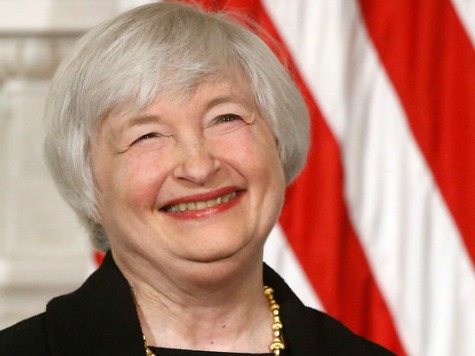On Thursday Federal Reserve Board Vice Chairman Janet Yellen appears before the Senate Banking Committee to defend her nomination to succeed Fed Chairman Ben Bernanke, who received the weakest approval ever from the Senate when he was confirmed in February 2010. His second term as Chairman ends January 31, 2014, although Bernanke’s term as a Fed governor runs through 2020.
Back on October 26th we ran a comment in Washington and Wall Street, “Rand Paul Right to Oppose Janet Yellen.” One of the interesting things about Yellen is that she has been virtually absent from any public discussion of Fed policy over the past several months. Bloomberg News scribes Joshua Zumbrun, Jeff Kearns & Craig Torres report:
“Tomorrow, she’ll express her views publicly for the first time in seven months on the record stimulus she’s supported and that some lawmakers are using to justify voting against her. Testifying to the Senate Banking Committee, Yellen will try to defend a policy that’s swelled the Fed’s balance sheet to almost $4 trillion while facing four Republicans who voted no on her 2010 bid to be vice chairman.”
Today in simple terms, let’s frame a couple of basic questions that members of the Senate need to ask Vice Chairman Yellen tomorrow during the Senate hearing.
Q: Describe your justification for current Fed policy, particularly near-zero interest rates and massive Fed purchases of Treasury debt and agency securities? Why do you think these policies will grow jobs and consumer purchasing power?
Yellen will no doubt give the standard neo-Keynesian answer about using low interest rates to fulfill the Fed’s legal mandate to achieve full employment and stable prices. Senators should follow up with Yellen and ask her to describe her views on the trade-off between unemployment and inflation.
Q: Vice Chairman Yellen, do you believe in the Phillips Curve? If so, tell us why? If not, how can you support current Fed policy?
Economic research over the past 40 years has thrown a great deal of doubt onto whether a stable Phillips curve relationship exists at all. Because of the ridiculous “dual mandate” imposed upon the Fed by Congress with the Humphrey Hawkins Full Employment and Balanced Growth Act of 1978, however, the FOMC continues to use monetary policy as a tool to encourage employment. This leads to the next question.
Q: Why do you believe that maintaining very low interest rates will spur job growth?
Adding to the Phillips Curve insanity, Yellen apparently has taken the goals of Humphrey-Hawkins to heart and has developed a thesis called “optimal control” whereby the Fed will tolerate above-target rates of inflation until the economy reaches a “natural” employment rate of ~ 6%. Matthew Boesler, in a timely article for Business Insider, notes that:
“Under the optimal control approach, the central bank would then use a model to calculate the optimal path of short-term interest rates in order to hit these targets. As long as unemployment is further away from the target level than inflation, then monetary policymakers would keep interest rates low in an attempt to correct this, even if it means inflation runs slightly above target for a while.”
Q: Why do you believe that a 2% inflation rate is an acceptable public policy target? Won’t a 2% inflation rate, sustained over a period of years, destroy the real purchasing power of consumers and employers? How does this help to boost spending and job creation?
The central fallacy of our time when it comes to American monetary policy is that the Fed, via manipulation of interest rates and the financial markets can alter the employment situation without stoking inflation. The “Keynesian Conceit” which says that social engineers can guide an economy via top-down policies without fueling horrific “bubbles” in financial assets and other areas besides wage/price inflation is horribly flawed, yet just this thinking is accepted by Yellen, the majority of economists and their partners in the media. The Fed’s extreme monetary policies since 2008, added to new “reform” legislation such as Dodd-Frank, mark the most aggressive social engineering attempted in the US since the New Deal socialism of FDR. Thus the final question for Yellen (and the rest of the FOMC):
Q: To what extent is the Dodd-Frank law, Basel III and other new regulations meant to avoid future financial crises thwarting the Fed’s efforts to bolster growth and employment? Is excessive regulation thwarting credit creation and thus job growth?
The answer to the last question is obviously yes, but Yellen and the other folks who work at the Fed’s Washington HQ will never admit it in public. The very low interest rate policies that the Fed hopes will help the job scene and boost consumption are already creating asset bubbles throughout the financial world. As I note in a recent post on Zero Hedge, “Q3 Earnings Roundup: Banks, Non-Banks and the FOMC”:
“Along with the income shrinkage on savers of QE, the regulatory environment created by Dodd-Frank is retarding credit expansion for the private sector, hurting consumption and employment. But the interest rate risk created by the Fed after years of zero rates is very real and may soon be “Topic A” for Janet Yellen and other members of the Federal Open Market Committee. It’s like we all know that the emperor is naked, but none of us, not even the smallest child, is willing to say so.”

COMMENTS
Please let us know if you're having issues with commenting.